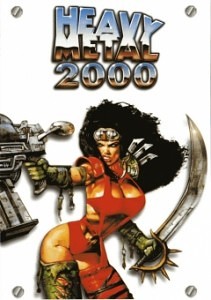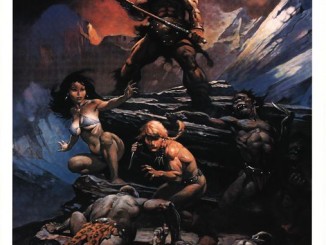In a multi-part series, Comic Book Film Editor William Gatevackes will be tracing the history of comic book movies from the earliest days of the film serials to today’s big blockbusters and beyond. Along with the history lesson, Bill will be covering some of the most prominent comic book films over the years and why they were so special. This time, we discuss the strange journey of Heavy Metal from Europe to America to the Silver Screen.
National Lampoon has given us a lot over the years. It has given us writers such as Doug Kenney, Michael O’Donaghue, P.J. O’Rourke and John Hughes. It gave exposure to comic actors like John Belushi, Gilda Radner, Christopher Guest, Chevy Chase and Bill Murray. It has even “Presented” films like Animal House, Vacation, and Van Wilder.
 It has also, in a roundabout way, given us the film Heavy Metal, too. Well, at least the magazine the movie was based on.
It has also, in a roundabout way, given us the film Heavy Metal, too. Well, at least the magazine the movie was based on.
Heavy Metal magazine began as the French magazine Métal Hurlant, an anthology graphic magazine started in 1974 by legendary French artists Jean Giraud A.K.A. Mœbius and Philippe Druillet. It presented comics drawn and written from a distinctly European point of view, along with text articles on all areas of popular culture.
National Lampoon publisher Leonard Mogel was in Paris to try and get Lampoon published in France when he stumbled across Métal Hurlant (which stands for “Howling Metal”) and saw it as something that might work in the United States. He licensed the magazine, renamed it Heavy Metal to have it resonate with American audiences more and started publishing it on high-stock glossy paper as a monthly magazine.
The mag gave European artists such as Giraud, Milo Manara and Esteban Maroto exposure in the U.S. as their work in Métal Hurlant was translated and reprinted in Heavy Metal. It featured work from such luminaries as H.R. Giger, Stephen King, Harlan Ellison and William S. Burroughs in its pages. And it published serials by artists like Arthur Suydam, Bernie Wrightson and Howard Cruse, among others.
It’s these serials that got adapted into the 1981 film, Heavy Metal, which like the magazine was an anthology of stories inspired and written by creators that worked for the periodical.
 The film featured six installments with a framing sequence tied together by one mystical object, a glowing green sphere of unearthly power called the Loc-Nar. The individual installments feature the distinctive variety of styles that were at home in the magazine, ranging from futuristic noir to historical horror, from imaginative fantasy to satiric humor. The film was produced by Ivan Reitman, featured the voices of SCTVers John Candy, Joe Flaherty, Eugene Levy and Harold Ramis. And it had an eclectic soundtrack that featured Black Sabbath, Blue Oyster Cult, Stevie Nicks, Devo and Cheap Trick. That line up of musicians was one of the reasons why the film took so long to be released on home video, as nailing down the rights to the music became an issue.
The film featured six installments with a framing sequence tied together by one mystical object, a glowing green sphere of unearthly power called the Loc-Nar. The individual installments feature the distinctive variety of styles that were at home in the magazine, ranging from futuristic noir to historical horror, from imaginative fantasy to satiric humor. The film was produced by Ivan Reitman, featured the voices of SCTVers John Candy, Joe Flaherty, Eugene Levy and Harold Ramis. And it had an eclectic soundtrack that featured Black Sabbath, Blue Oyster Cult, Stevie Nicks, Devo and Cheap Trick. That line up of musicians was one of the reasons why the film took so long to be released on home video, as nailing down the rights to the music became an issue.
In 1992, longtime Heavy Metal fan and co-creator of the Teenage Mutant Ninja Turtles Kevin Eastman bought the magazine and set himself up as publisher and editor. Heavy Metal 2000 was released early on in Eastman’sreign as publisher, but had more to do with the man then the magazine.
 Heavy Metal 2000 was not adapted from a story that appeared in the pages of the magazine, but rather from a 1995 miniseries Eastman did with artist Simon Bisley called The Melting Pot which was published by Kitchen Sink Press. The original comic was not an anthology, so the film contains only one story, not six like the first Heavy Metal. It does feature a diverse soundtrack with many songs from popular alternative and metal acts of the day, like Queens of the Stone Age and System of a Down. And a glowing green rock does play a role in the proceedings, to sort of tie it in with the first film.
Heavy Metal 2000 was not adapted from a story that appeared in the pages of the magazine, but rather from a 1995 miniseries Eastman did with artist Simon Bisley called The Melting Pot which was published by Kitchen Sink Press. The original comic was not an anthology, so the film contains only one story, not six like the first Heavy Metal. It does feature a diverse soundtrack with many songs from popular alternative and metal acts of the day, like Queens of the Stone Age and System of a Down. And a glowing green rock does play a role in the proceedings, to sort of tie it in with the first film.
The plot focuses on Julie (voiced by, and most certainly inspired by, Eastman’s then-wife, B-movie actress and former Penthouse Pet of the Year Julie Strain) fighting an evil tyrant with the power of self-regeneration. She fights to free her sister from the tyrant’s captivity, all the while trying to end his reign of terror.
There is another film in the works, at the very least loosely connected to the Heavy Metal brand called War of the Worlds: Goliath.
 The film is a sequel to H.G. Wells’ novel, War of the Words, and appears to be some kind of steampunk manga film. It is voiced by Adrian Paul and Adam Baldwin, among others. It is set for a 2012 release, however, footage was shown during the 2009 San Diego Comic Con with a promised 2010 DVD release. Since it was already delayed two years, I’d say that 2012 date should be taken with a grain of salt.
The film is a sequel to H.G. Wells’ novel, War of the Words, and appears to be some kind of steampunk manga film. It is voiced by Adrian Paul and Adam Baldwin, among others. It is set for a 2012 release, however, footage was shown during the 2009 San Diego Comic Con with a promised 2010 DVD release. Since it was already delayed two years, I’d say that 2012 date should be taken with a grain of salt.
There has been a planned remake of the original in the works, first helmed by David Fincher and then by Robert Rodriguez. Considering Rodriguez’s track record of getting films he is attached to made is about one in four, it might be a while if there will be another Heavy Metal film in the future.
Next time, Swamp Thing gets revitalized in the comics and a film in theaters within years of one another. Did one have any effect on the other?



